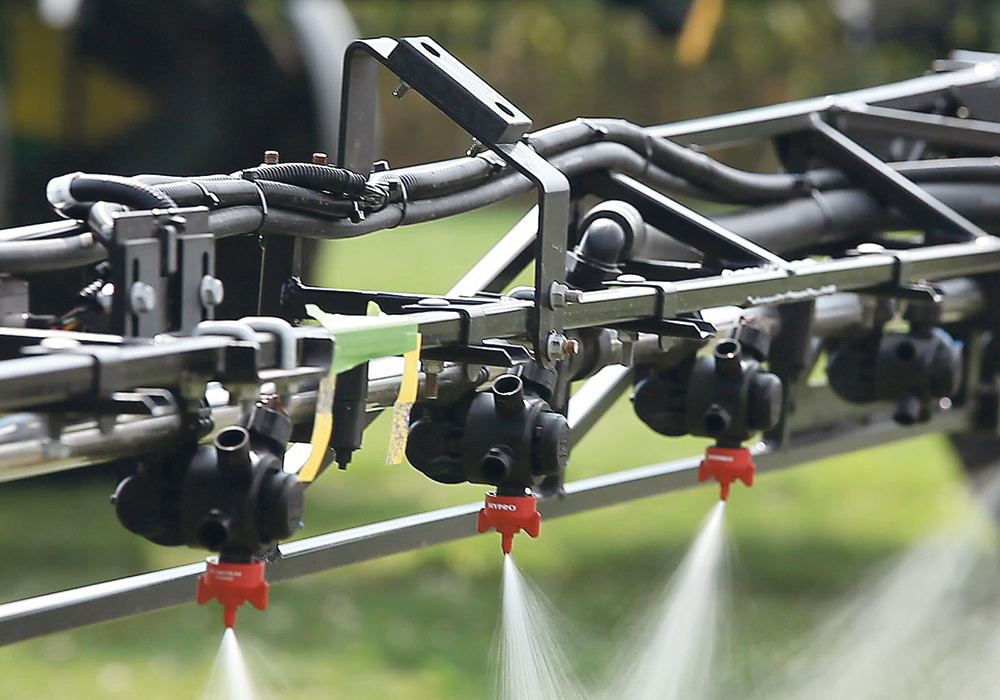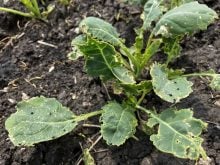When moisture limits a crop, there may be fewer and less vigorous weeds, and weed emergence may be delayed until rainfall occurs.
In those conditions, farmers may be tempted to delay spraying until they get some moisture. However, drought-tolerant weeds such as kochia, Russian thistle, and foxtail barley develop extensive root systems early and take advantage of limited water, making them more competitive and difficult to control than when soil moisture is adequate.
They are able to successfully compete with your crop for that valuable water.
Read Also

Growing garlic by the thousands in Manitoba
Grower holds a planting party day every fall as a crowd gathers to help put 28,000 plants, and sometimes more, into theground
Hot and dry conditions will impact the weed control you can expect from a herbicide. Unfortunately, it may also increase the crop injury from herbicides. Every herbicide you use will be influenced by environmental conditions.
Generally, herbicides are most effective when applied to actively growing plants at 20 C to 30 C.
Most herbicide labels caution against treating plants growing under extreme environmental conditions or stress because treatment of stressed plants can result in increased crop injury and decreased weed control.
This is an excerpt from a commonly used herbicide label. Wheat exposed to water-logged or saturated soils, or temperature extremes such as heat or freezing weather, or drought, low fertility or plant disease at application time could show unacceptable injury symptoms. Weed control also may be reduced by these same conditions.
As well, weeds often become more tolerant to many herbicides. Many plants may develop a thicker wax layer or cuticle on the leaf surface to prevent water loss. This layer acts as a barrier to herbicide uptake into the weed. Also, herbicide movement within the weed will likely be reduced due to a slowed rate of translocation and metabolism of the plant. Because of these situations, application of herbicides under such conditions often results in reduced weed control.
This will be of most concern with the application of systemic herbicides such as most glyphosate, sulfonylurea, imidazolinone herbicides, phenoxy or growth regulator herbicides as well as grass herbicides like Assure II, Select/Centurian (clethodim), Puma (fenoxaprop) and Horizon (clodinafop). Application early in the morning after the plants have recovered from the heat of the previous day may provide better weed control than afternoon or evening application. Use the highest label rates for this group of herbicides.
The addition of adjuvants or surfactants, when recommended, also may improve weed control from these herbicides under adverse growing conditions.
The use of higher water volumes and a coarser spray may also increase performance of systemic herbicides under drought conditions. Low humidity results in rapid drying of spray droplets in the air, which results in smaller droplets more prone to drift. Droplets that land on target weeds will dry faster under low humidity, resulting in less time for absorption into the leaf. Using a fine spray when temperatures are high and the humidity is low may result in the water carrier of the herbicide evaporating before it ever reaches the target weed. Increasing water volumes and droplet size while avoiding spraying in the heat of the day may help reduce this issue.
Most contact herbicides become more active as temperatures increase. This may provide improved weed control but can also result in greater crop injury.
Contact herbicides such as Aim, Basagran, Buctril M, Gramoxone, Infinity, Liberty, Sencor, Ultra Blazer and Viper all need to be used with caution when temperatures reach 30 C or higher. Postpone application of these herbicides if temperatures exceed 32 C to reduce risk of crop injury.
However, good weed control with contact herbicides depends on timely application. The best control generally is achieved with thorough ideal spray coverage due to higher spray water volumes and application to smaller, seedling weeds.
While waiting until temperatures subside will lessen the risk of crop injury, the weeds may develop beyond the optimum treatment stage if application is delayed too long. In some cases, application of reduced herbicide rates may be better than delaying application, even when temperatures are more than 32 C.
Precautions can be taken to minimize the risk for injury with contact herbicides during hot weather. Using the lower recommended rates on the label rather than higher rates, even if attempting to control larger or less susceptible weeds, reduces risk. The activity of contact herbicides is increased on all plants at higher temperatures, so the weeds also will be more susceptible to the treatment. Avoid adding surfactants or adjuvants, even if labelled, to contact herbicides because these will increase the risk of crop injury.
The most critical time for crop injury following application of a contact herbicide is the first few hours after treatment. Injury can be minimized by applying the herbicide in the evening after the temperature has begun to drop. Applications in the evening will allow several hours of moderate temperatures following treatment while morning application will be followed immediately by high temperatures, potentially causing more damage.
With most herbicides, crop competition also contributes to weed control. Because the crop will not be as competitive under drought conditions, weeds may look controlled, but may regrow later in the season if rainfall is received.


















